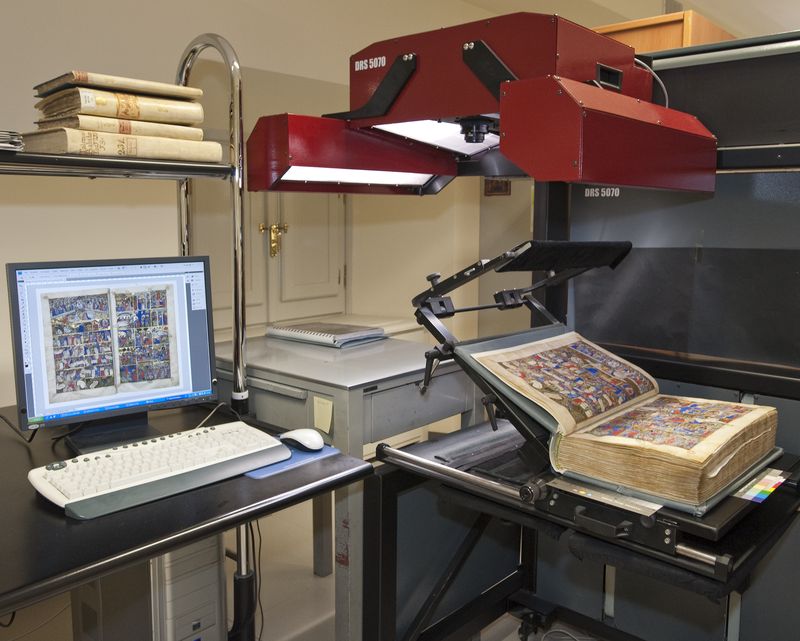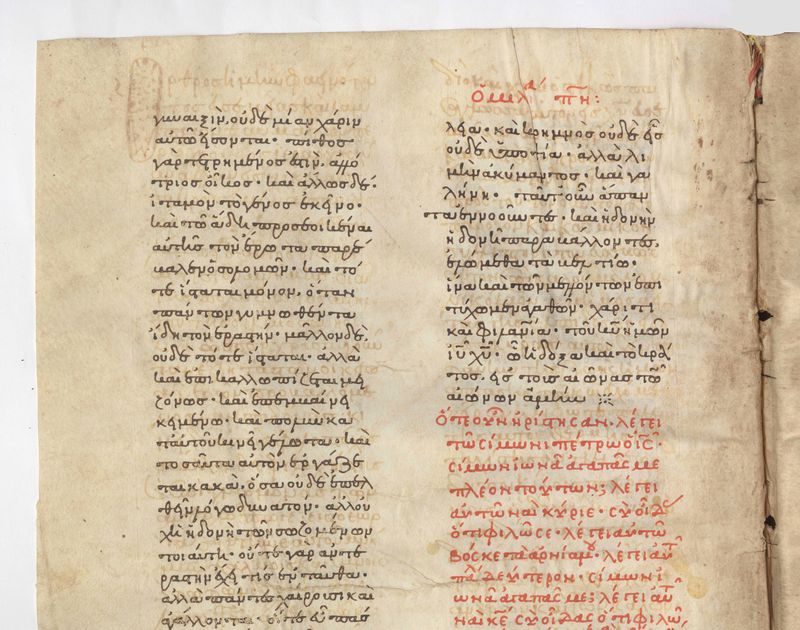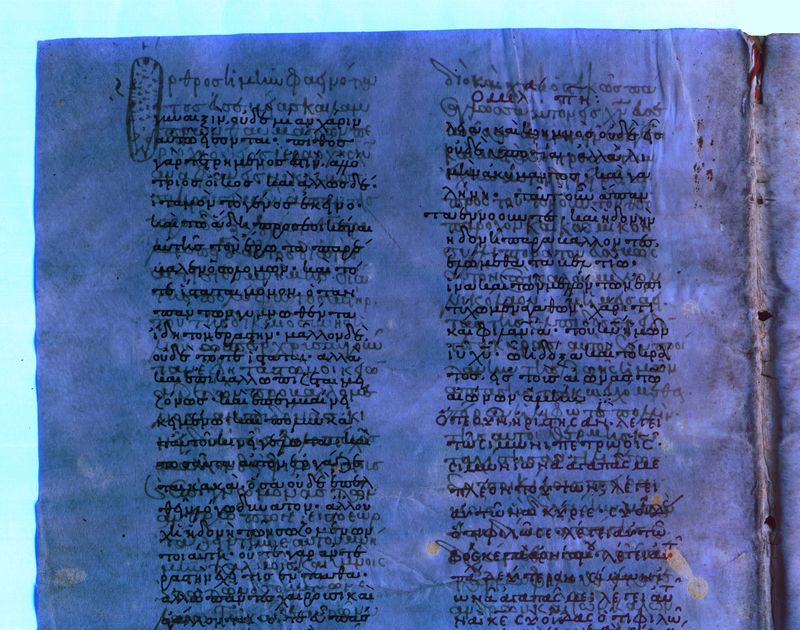Photographic Laboratory
The Photographic Laboratory of the Vatican Apostolic Library performs photographic reproductions of the Library's materials, both for internal use and for scholars (photographic requests), by putting in place, in the reproduction work, the necessary precautions to preserve the material from possible damages.
THE PAST
1898
Already in 1898, at the International conference of St. Gallen regarding the conservation of manuscripts promoted by Father Franz Ehrle (Prefect of the Vatican Library from 1895 to 1914), the need to perform photographic reproductions of the codices in order to be able to document their conservation state and the results of the restoration works carried out on them, was emphasized.
Second part of the 19th century - the Thirties of the 20th century


with ultraviolet radiation (1942)
The Fifties
A special project of microfilming took place after the second world war: material destruction, as a result
of military operations, persuaded Pope Pius XII to create an overseas security deposit for the microfilms of
Vatican manuscripts. Thus, in the early 1950s, a ten-year microfilming campaign started, during which
about 70% of the Vatican manuscripts were reproduced. The Library has made available the consultation of
such microfilms at the Pius XII Memorial Library, specially
created at Saint Louis University (U.S.A).


Between the 1960s and the 1980s
In the following years, until the introduction of the Digital Laboratory, the equipment for microfilming and for
the production of plates seemed so adequate and sufficiently up-to-date that no major innovations were deemed necessary.
However, portable 35 mm cameras were purchased, as well as a new reflex camera for 6x7 format, a new optical bench and
a large number of more recent photographic accessories.
In the 1970's the optical bench for 18x24 cm films was the most largely used, together with the optical
bench for the 13x18 cm format. These traditional instruments were used to produce a large quantity
of 13x18 ektachromes for study and publication of manuscripts, as well as many 20x25 ektachromes for the
production (in collaboration with external companies) of high quality facsimiles of manuscripts.
An important reference for the laboratory's activity during those years was an International Conference for
the protection and reproduction of manuscripts and antique printed books, promoted in 1975 by the Vatican Library.
During the Conference, photographic reproduction in its conceptual, technical, financial and juridical aspects was
faced; in the final considerations of the Conference emerge, with clear foresight, the consciousness of the need
to create complete archives of reproductions of the manuscripts for the protection of the originals
(in fact, a key topic is the "Sicherheitsverfilmung" on microfilm) as well as for their diffusion; the need for
standardization of machinery and techniques and the hope of collaboration to achieve uniform practices as well
as excellent and durable quality results.

in 1975
THE PRESENT
- Currently, the Photographic Laboratory uses digital technologies (gradually adopted since 1994). The activity of completing the patrimony on microfilm continues, but, conversely to what was done in the microfilming project of the fifties of the twentieth century, the acquisition no longer takes place directly from the original but through the migration of digital files on film.
- We use Nikon cameras and Hasselblad digital backs mounted on columns or connected to book cradles. Metis scanners and i2S scanners are also in use as well as various desktop scanners and printers of different sizes and brands and machines for the transfer of image files on film and for microfilm development. The photographic staff is highly qualified and continuously updated on imaging and image processing techniques.
- Capturing techniques are appropriately standardized and are in line with international standards for photographic acquisition of manuscripts and rare books. Images acquired according to the rules of "best practice", provided with chromatic and millimeter scales and stored at native resolution, contribute to the preservation of the original, and are a prerequisite for the long-term preservation of the electronic data (Digital Preservation). In this perspective, each page is interleaved with white paper to ensure that its photograph accurately reflects the original by showing every little detail, such as holes in the parchment or paper support or other irregularities.
- The Photographic Laboratory, as it is in its tradition since its establishment, cultivates avant-garde experimental activities with multispectral and transversal techniques, for example by documenting watermarks, by carrying out an important project to recover its palimpsests, and by giving access – respecting the integrity of the original – to materials that are compromised by corrosive ink or mold.



RGB image

UV image

postprocessed
THE DIGITIZING PROJECT
http://library.ifla.org/2113/1/160-manoni-en.pdf
- In 2010 the Vatican Library has launched an ambitious digital preservation project, conceived as a work of several years and with international collaborations, digitizing on a large scale its manuscripts and, exceptionally, also its printed books, in consideration of the main of the final recommendations of the International Conference of 1975: the need to establish complete archives of reproductions, acquiring permanent photographic masters that will be suitable for any future use. The Photographic Laboratory, in collaboration with the Conservation Workshop, the IT Service Management and the Data Processing Center, coordinates and manages these activities promoted by the Library, providing for the adequate application of the reproduction techniques, the double control of all images and the regular update of procedures and equipment.
- Before starting this imposing activity, a feasibility study was carried out, followed by a test phase during which the technical aspects for the adequate photographic acquisition of the images were developed, as well as those related to the creation of an efficient workflow (that has been continuously adapted, as a digitizing project is a work in progress), and also those related to the correct long-term archiving of the digital heritage objects, in addition to the access that should have been given to these virtual copies in a Networking Digital Library (https://digi.vatlib.it/). The Vatican Library, for its DigiVatLib platform, has adopted the IIIF standard that permits the collections to be interoperable.

LONG-TERM PRESERVATION OF HIGH RESOLUTION IMAGES
- Long-term preservation of digital resources does not mean a guarantee certificate for a certain amount of years, but the responsible development of strategies in order to face constant technological changes.
- For the permanent conservation and preservation of the digital data, cf. (Digital Preservation)
- In the context of digital preservation of books, color is an important information to be preserved and reproduced as faithfully as possible to the original (The Color space)
ANALOGUE PHOTOGRAPHIC ARCHIVE
The Photographic Archive preserves the masters of the analogue photographs made by the Laboratory. It is an
important archival and documentary heritage. The Archive preserves and guarantees access to photographs
that are research tools as well as research objects. Among the Archive’s functions there is also the
historical-documental one: the photographs show the state of the manuscript at the time when they were
made; in some case they show how it appeared before damage or before restoration.

Holdings of the Photographic Archive:
- 54.000 microfilms of the Vatican manuscripts, reproduced entirely;
- 33.000 35mm color slides and 10.000 13x18 ektachromes;
- 35.000 b/w negatives in large format;
- The microfiches of the printed books of the Palatina collection, and of the Cicognara collection (THE CICOGNARA PROJECT).
CONTACT DETAILS
- PERSON IN CHARGE Emanuele Angelini: Compose mail
- Tel: +39/06698.79414
- Office: Compose mail
- For reproductions and publication rights: Reproductions and Rights Office





